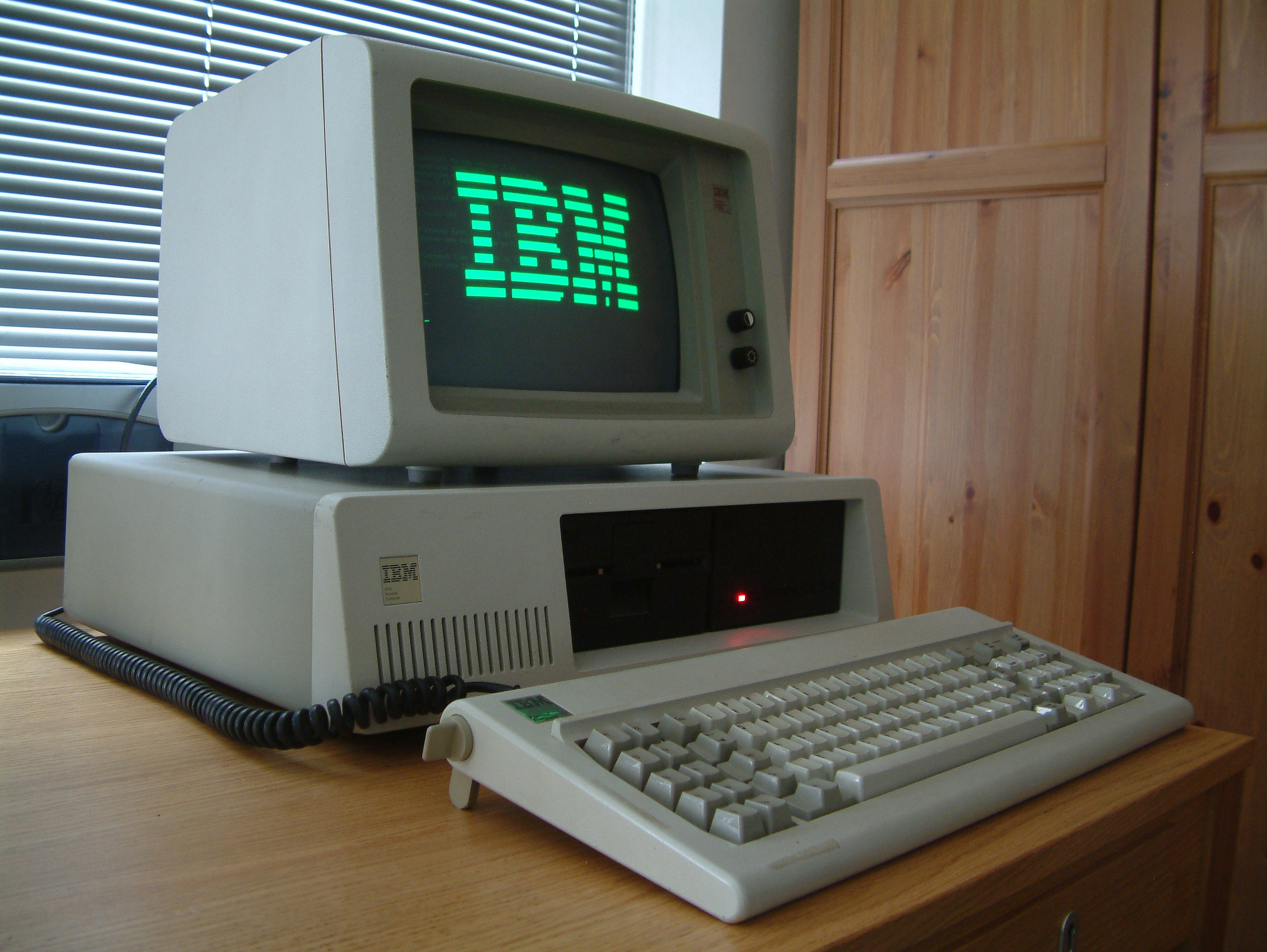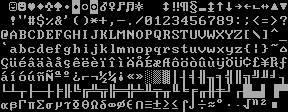|
IBM 5151
The IBM 5151 is a 12" transistor–transistor logic (TTL) monochrome monitor, shipped with the original IBM Personal Computer for use with the IBM Monochrome Display Adapter. A few other cards were designed to work with it, such as the Hercules Graphics Card The Hercules Graphics Card (HGC) is a computer graphics controller made by Hercules Computer Technology, Inc. that combines IBM's text-only MDA display standard with a bitmapped graphics mode. This allows the HGC to offer both high-quality text an .... The monitor has an 11.5-inch wide CRT (measured diagonally) with 90 degree deflection, etched to reduce glare, with a resolution of 350 horizontal lines and a 50 Hz refresh rate. It uses TTL digital inputs through a 9-pin D-shell connector, being able to display at least three brightness levels, according to the different pin 6 and 7 signals. It is also plugged into the female AC port on the IBM PC power supply, and thus did not have a power switch of its own. The IBM 515 ... [...More Info...] [...Related Items...] OR: [Wikipedia] [Google] [Baidu] |
Transistor–transistor Logic
Transistor–transistor logic (TTL) is a logic family built from bipolar junction transistors. Its name signifies that transistors perform both the logic function (the first "transistor") and the amplifying function (the second "transistor"), as opposed to earlier resistor–transistor logic (RTL) and diode–transistor logic (DTL). TTL integrated circuits (ICs) were widely used in applications such as computers, industrial controls, test equipment and instrumentation, consumer electronics, and synthesizers. After their introduction in integrated circuit form in 1963 by Sylvania Electric Products, TTL integrated circuits were manufactured by several semiconductor companies. The 7400 series by Texas Instruments became particularly popular. TTL manufacturers offered a wide range of logic gates, flip-flops, counters, and other circuits. Variations of the original TTL circuit design offered higher speed or lower power dissipation to allow design optimization. TTL devices were original ... [...More Info...] [...Related Items...] OR: [Wikipedia] [Google] [Baidu] |
Monochrome Monitor
A monochrome monitor is a type of computer monitor in which computer text and images are displayed in varying tones of only one color, as opposed to a color monitor that can display text and images in multiple colors. They were very common in the early days of computing, from the 1960s through the 1980s, before color monitors became widely commercially available. They are still widely used in applications such as computerized cash register systems, owing to the age of many registers. Green screen was the common name for a monochrome monitor using a green "P1" phosphor screen; the term is often misused to refer to any block mode display terminal, regardless of color, e.g., IBM 3279, 3290. Abundant in the early-to-mid-1980s, they succeeded Teletype terminals and preceded color CRTs and later LCDs as the predominant visual output device for computers. CRT Design The most common technology for monochrome monitors was the CRT, although, e.g., plasma displays, were also used. ... [...More Info...] [...Related Items...] OR: [Wikipedia] [Google] [Baidu] |
IBM Personal Computer
The IBM Personal Computer (model 5150, commonly known as the IBM PC) is the first microcomputer released in the IBM PC model line and the basis for the IBM PC compatible de facto standard. Released on August 12, 1981, it was created by a team of engineers and designers directed by Don Estridge in Boca Raton, Florida. The machine was based on open architecture and third-party peripherals. Over time, expansion cards and software technology increased to support it. The PC had a influence of the IBM PC on the personal computer market, substantial influence on the personal computer market. The specifications of the IBM PC became one of the most popular computer design standards in the world. The only significant competition it faced from a non-compatible platform throughout the 1980s was from the Apple Macintosh product line. The majority of modern personal computers are distant descendants of the IBM PC. History Prior to the 1980s, IBM had largely been known as a provider of ... [...More Info...] [...Related Items...] OR: [Wikipedia] [Google] [Baidu] |
IBM Monochrome Display Adapter
The Monochrome Display Adapter (MDA, also MDA card, Monochrome Display and Printer Adapter, MDPA) is IBM's standard video display card and computer display standard for the IBM PC introduced in 1981. The MDA does not have any pixel-addressable graphics modes, only a single monochrome text mode which can display 80 columns by 25 lines of high resolution text characters or symbols useful for drawing forms. Hardware design The original IBM MDA was an 8-bit ISA card with a Motorola 6845 display controller, 4 KB of RAM, a DE-9 output port intended for use with an IBM monochrome monitor, and a parallel port for attachment of a printer, avoiding the need to purchase a separate card. Capabilities The MDA was based on the IBM System/23 Datamaster's display system, and was intended to support business and word processing use with its sharp, high-resolution characters. Each character is rendered in a box of 9×14 pixels, of which 7×11 depicts the character itself and the othe ... [...More Info...] [...Related Items...] OR: [Wikipedia] [Google] [Baidu] |
Hercules Graphics Card
The Hercules Graphics Card (HGC) is a computer graphics controller made by Hercules Computer Technology, Inc. that combines IBM's text-only MDA display standard with a bitmapped graphics mode. This allows the HGC to offer both high-quality text and graphics from a single card. The HGC was very popular, and became a widely supported de facto display standard on IBM PC compatibles. The HGC standard was used long after more technically capable systems had entered the market, especially on dual-monitor setups. History The Hercules Graphics Card was released to fill a gap in the IBM video product lineup. When the IBM Personal Computer was launched in 1981, it had two graphics cards available, the Color Graphics Adapter (CGA) and the Monochrome Display And Printer Adapter (MDA). CGA offers low-resolution (320x200) color graphics and medium-resolution (640x200) monochrome graphics, while MDA offers a sharper text mode (equivalent of 720×350) but has no per-pixel addressing modes and ... [...More Info...] [...Related Items...] OR: [Wikipedia] [Google] [Baidu] |
Phosphor
A phosphor is a substance that exhibits the phenomenon of luminescence; it emits light when exposed to some type of radiant energy. The term is used both for fluorescent or phosphorescent substances which glow on exposure to ultraviolet or visible light, and cathodoluminescent substances which glow when struck by an electron beam (cathode rays) in a cathode-ray tube. When a phosphor is exposed to radiation, the orbital electrons in its molecules are excited to a higher energy level; when they return to their former level they emit the energy as light of a certain color. Phosphors can be classified into two categories: fluorescent substances which emit the energy immediately and stop glowing when the exciting radiation is turned off, and phosphorescent substances which emit the energy after a delay, so they keep glowing after the radiation is turned off, decaying in brightness over a period of milliseconds to days. Fluorescent materials are used in applications in which the ... [...More Info...] [...Related Items...] OR: [Wikipedia] [Google] [Baidu] |
Flicker (screen)
Flicker is a visible change in brightness between cycles displayed on video displays. It applies to the refresh interval on cathode ray tube (CRT) televisions and computer monitors, as well as plasma computer displays and televisions. Occurrence Flicker occurs on CRTs when they are driven at a low refresh rate, allowing the brightness to drop for time intervals sufficiently long to be noticed by a human eye – see persistence of vision and flicker fusion threshold. For most devices, the screen's phosphors quickly lose their excitation between sweeps of the electron gun, and the afterglow is unable to fill such gaps – see phosphor persistence. A refresh rate of 60 Hz on most screens will produce a visible "flickering" effect. Most people find that refresh rates of 70–90 Hz and above enable flicker-free viewing on CRTs. Use of refresh rates above 120 Hz is uncommon, as they provide little noticeable flicker reduction and limit available resolution. ... [...More Info...] [...Related Items...] OR: [Wikipedia] [Google] [Baidu] |





